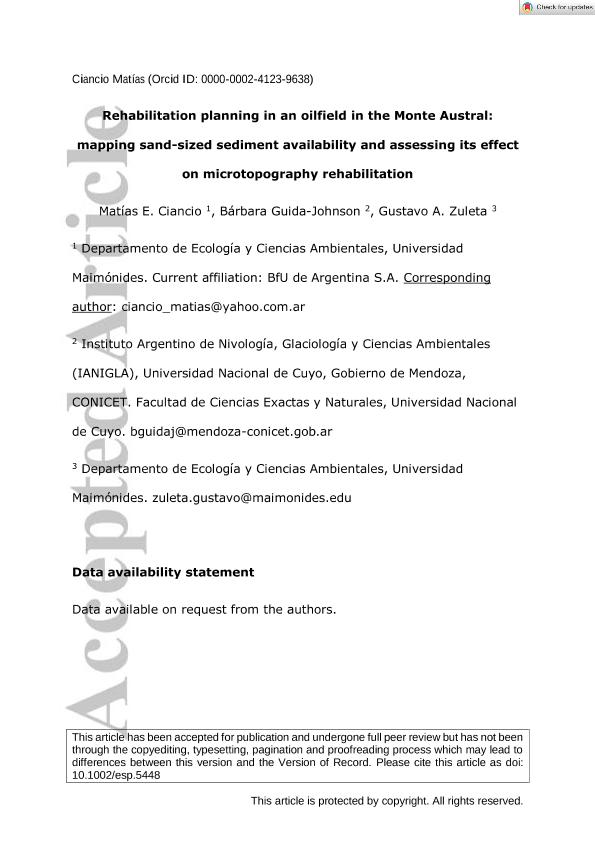Mostrar el registro sencillo del ítem
dc.contributor.author
Ciancio, Matías Ezequiel

dc.contributor.author
Guida Johnson, Bárbara

dc.contributor.author
Zuleta, Gustavo Adolfo

dc.date.available
2023-07-11T12:48:16Z
dc.date.issued
2022-10
dc.identifier.citation
Ciancio, Matías Ezequiel; Guida Johnson, Bárbara; Zuleta, Gustavo Adolfo; Rehabilitation planning in an oilfield in the Monte Austral: Mapping sand-sized sediment availability and assessing its effect on microtopography rehabilitation; John Wiley & Sons Ltd; Earth Surface Processes And Landforms; 47; 13; 10-2022; 3133-3146
dc.identifier.issn
0197-9337
dc.identifier.uri
http://hdl.handle.net/11336/203177
dc.description.abstract
In drylands, the microtopography is formed by mound-shaped dunes of eolian deposition that occur around shrubs or other vegetation in clumps. These mounds are characteristic of the Monte Austral, which covers 20% of Argentina (approximately 50 million ha), has a strong water deficit and is subjected to land degradation by the oil industry. Considering the biogeomorphological approach, oilfield rehabilitation should begin with regeneration of the mounds as they provide safe sites for vegetation. Since rehabilitation success may be influenced by sand-sized sediment availability, we addressed two objectives: mapping the sediment availability in an oilfield and evaluating its effect on microtopography rehabilitation. We used a Sentinel-2 MSI scene and assessed three approaches to map the sediments: two expressions of the Normalized Difference Sand Index and the feature Brightness of the Tasselled Cap Transformation. We validated the three maps using a geomorphological map. Two maps showed the highest agreement with the geomorphological map and errors were associated with the detection of bright lithified or cohesive material not available for sediment transportation. Then, we evaluated the effect of sediments on microtopography rehabilitation. We compared the morphometric traits of mounds (height, maximum and minimum length) located in areas of low and high sediment availability, in both natural and scarified areas. We considered the time since scarification was applied (8–13, 4–8, or <4 years ago). The mounds in the natural areas were larger than the mounds in the scarified areas, so complete microtopography rehabilitation is not achieved 13 years after scarification. The mounds in high-sediment-availability areas were different from the initial condition 4 years after scarification, whereas differences took 8 years to become evident with low sediment availability. Sediment availability must be considered when designing rehabilitation techniques to ensure the success and sustainability of the project. Our results have implications for the development of a biogeomorphological model to guide rehabilitation planning.
dc.format
application/pdf
dc.language.iso
eng
dc.publisher
John Wiley & Sons Ltd

dc.rights
info:eu-repo/semantics/openAccess
dc.rights.uri
https://creativecommons.org/licenses/by-nc-sa/2.5/ar/
dc.subject
DRYLANDS
dc.subject
MOUNDS
dc.subject
OIL INDUSTRY
dc.subject
RESTORATION PLANNING
dc.subject
SATELLITE IMAGES
dc.subject
SCARIFICATION
dc.subject.classification
Ciencias Medioambientales

dc.subject.classification
Ciencias de la Tierra y relacionadas con el Medio Ambiente

dc.subject.classification
CIENCIAS NATURALES Y EXACTAS

dc.subject.classification
Sensores Remotos

dc.subject.classification
Ingeniería del Medio Ambiente

dc.subject.classification
INGENIERÍAS Y TECNOLOGÍAS

dc.title
Rehabilitation planning in an oilfield in the Monte Austral: Mapping sand-sized sediment availability and assessing its effect on microtopography rehabilitation
dc.type
info:eu-repo/semantics/article
dc.type
info:ar-repo/semantics/artículo
dc.type
info:eu-repo/semantics/publishedVersion
dc.date.updated
2023-07-05T15:22:25Z
dc.journal.volume
47
dc.journal.number
13
dc.journal.pagination
3133-3146
dc.journal.pais
Reino Unido

dc.journal.ciudad
Londres
dc.description.fil
Fil: Ciancio, Matías Ezequiel. Consejo Nacional de Investigaciones Científicas y Técnicas; Argentina. Universidad Maimonides. Area de Invest.biomédicas y Biotecnológicas. Cent.d/est.biomedic.,biotecn.,ambient.y Diagnost.. Departamento de Ecología y Cs.ambientales; Argentina. BfU de Argentina S.A.; Argentina
dc.description.fil
Fil: Guida Johnson, Bárbara. Consejo Nacional de Investigaciones Científicas y Técnicas. Centro Científico Tecnológico Conicet - Mendoza. Instituto Argentino de Nivología, Glaciología y Ciencias Ambientales. Provincia de Mendoza. Instituto Argentino de Nivología, Glaciología y Ciencias Ambientales. Universidad Nacional de Cuyo. Instituto Argentino de Nivología, Glaciología y Ciencias Ambientales; Argentina
dc.description.fil
Fil: Zuleta, Gustavo Adolfo. Consejo Nacional de Investigaciones Científicas y Técnicas; Argentina. Universidad Maimonides. Area de Invest.biomédicas y Biotecnológicas. Cent.d/est.biomedic.,biotecn.,ambient.y Diagnost.. Departamento de Ecología y Cs.ambientales; Argentina
dc.journal.title
Earth Surface Processes And Landforms

dc.relation.alternativeid
info:eu-repo/semantics/altIdentifier/url/https://onlinelibrary.wiley.com/doi/10.1002/esp.5448
dc.relation.alternativeid
info:eu-repo/semantics/altIdentifier/doi/http://dx.doi.org/10.1002/esp.5448
Archivos asociados
